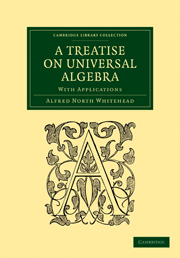Book contents
- Frontmatter
- PREFACE
- Contents
- BOOK I PRINCIPLES OF ALGEBRAIC SYMBOLISM
- BOOK II THE ALGEBRA OF SYMBOLIC LOGIC
- BOOK III POSITIONAL MANIFOLDS
- BOOK IV CALCULUS OF EXTENSION
- CHAPTER I COMBINATORIAL MULTIPLICATION
- CHAPTER II REGRESSIVE MULTIPLICATION
- CHAPTER III SUPPLEMENTS
- CHAPTER IV DESCRIPTIVE GEOMETRY
- CHAPTER V DESCRIPTIVE GEOMETRY OF CONICS AND CUBICS
- CHAPTER VI MATRICES
- BOOK V EXTENSIVE MANIFOLDS OF THREE DIMENSIONS
- BOOK VI THEORY OF METRICS
- BOOK VII APPLICATION OF THE CALCULUS OF EXTENSION TO GEOMETRY
- Index
CHAPTER IV - DESCRIPTIVE GEOMETRY
Published online by Cambridge University Press: 29 August 2010
- Frontmatter
- PREFACE
- Contents
- BOOK I PRINCIPLES OF ALGEBRAIC SYMBOLISM
- BOOK II THE ALGEBRA OF SYMBOLIC LOGIC
- BOOK III POSITIONAL MANIFOLDS
- BOOK IV CALCULUS OF EXTENSION
- CHAPTER I COMBINATORIAL MULTIPLICATION
- CHAPTER II REGRESSIVE MULTIPLICATION
- CHAPTER III SUPPLEMENTS
- CHAPTER IV DESCRIPTIVE GEOMETRY
- CHAPTER V DESCRIPTIVE GEOMETRY OF CONICS AND CUBICS
- CHAPTER VI MATRICES
- BOOK V EXTENSIVE MANIFOLDS OF THREE DIMENSIONS
- BOOK VI THEORY OF METRICS
- BOOK VII APPLICATION OF THE CALCULUS OF EXTENSION TO GEOMETRY
- Index
Summary
Application To Descriptive Geometry. An extensive manifold of ν - 1 dimensions is a positional manifold of ν - 1 dimensions with other properties superadded. These farther properties have in general no meaning for a positional manifold merely as such. But yet it is often possible conveniently to prove properties of all positional manifolds by reasoning which introduces the special extensive properties of extensive manifolds. This is due to the fact that the calculus of extension and some of the properties of extensive manifolds are capable of a partial interpretation which construes them merely as directions to form ‘constructions’ in a positional manifold. Ideally a construction is merely an act of fixing attention upon a certain aggregate of elements so as to mark them out in the mind apart from all others; physically, it represents some operation which makes the constructed objects evident to the senses. Now an extensive magnitude of any order, say the ρth, may be interpreted as simply representing the fact of the construction of the subregion of ρ - 1 dimensions which it represents. This interpretation leaves unnoticed that congruent products may differ by a numerical factor, and that, therefore, extensive magnitudes must be conceived as capable of various intensities.
- Type
- Chapter
- Information
- A Treatise on Universal AlgebraWith Applications, pp. 214 - 228Publisher: Cambridge University PressPrint publication year: 2009First published in: 1898

